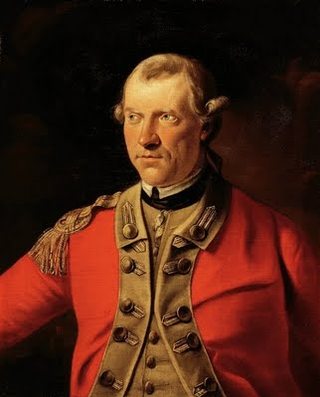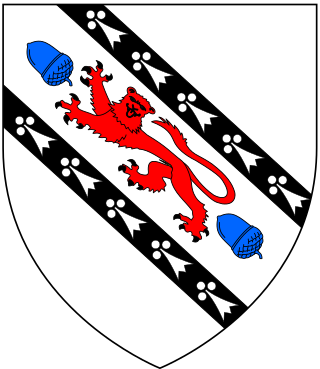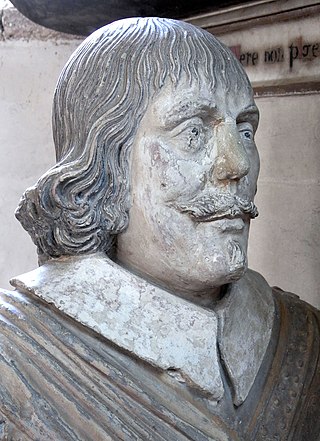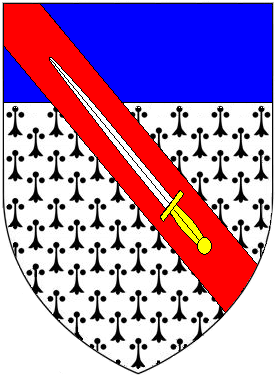
Major-General Henry Gladwin was a British army officer in colonial America and the British commander at the Siege of Fort Detroit during Pontiac's Rebellion in 1763. He served in the disastrous campaign of Edward Braddock and in other actions in the French and Indian War but is best remembered for his defense of Detroit in Pontiac's Rebellion.
John Burke was an Irish genealogist, and the original publisher of Burke's Peerage. He was the father of Sir Bernard Burke, a British officer of arms and genealogist.

Levett is a surname of Anglo-Norman origin, deriving from [de] Livet, which is held particularly by families and individuals resident in England and British Commonwealth territories.
Peregrine Hoby, was an English landowner and member of parliament who sat in the House of Commons at various times between 1640 and 1679.
The Sheriff of Nottinghamshire, Derbyshire and the Royal Forests is a position established by the Normans in England.

The Rodes Baronetcy, of Barlborough in the County of Derby, was a title in the Baronetage of England. It was created on 14 August 1641 for Francis Rodes, of Barlborough Hall, near Chesterfield, Derbyshire. The early family of Rodes was seated in Nottinghamshire. A William Rodes acquired an estate in Derbyshire by marriage. Sir Francis Rodes built Barlborough Hall in 1583–4. The first Baronet was his grandson. The title became extinct on the death of the fourth Baronet in 1743, when the estates passed to his sister's heirs, the Heathcotes and Heathcote-Rodes families.
William Monson, 1st Viscount Monson was one of the Regicides of King Charles I of England.

Sir John Northcote, 1st Baronet was an English politician who sat in the House of Commons at various times between 1640 and 1676. He supported the Parliamentarian cause in the English Civil War.
Sir William Wray, 1st Baronet, of Glentworth, Lincolnshire was an English Member of Parliament.

Francis Leke, 1st Earl of Scarsdale (1581–1655) of Sutton Scarsdale Hall, was an English peer who fought for the Royalist cause in the Civil War.

Sir John Carew, 3rd Baronet of Antony, Cornwall, was an English politician who sat in the House of Commons variously between 1660 and 1692.
Sir John Meux, 1st Baronet was an English politician who sat in the House of Commons from 1640 to 1643. He supported the Royalist cause in the English Civil War.
Captain Sir Thomas Liddell, 1st Baronet (1578–1652) was an English politician, a member of the Liddell family which monopolized the local government of the North of England during the 16th and 17th centuries. He was one of the leading supporters of the Royalist cause in the English Civil War.

The Palmes family of Naburn Hall, and the cadet branches of Lindley Hall, North Yorkshire; Ashwell, Rutland; and Carcraig in Ireland, are an ancient English aristocratic family, noted for their adherence to Catholicism.

Sir Godfrey de Foljambe was a prominent landowner and politician in fourteenth-century England, who was a Baron of the Exchequer and chief steward of the duchy of Lancaster. He went on to have a successful career as an Irish judge, including three years as Lord Chief Justice of Ireland. He was initially a servant of Philippa of Hainault before becoming a prominent member of the affinity of her son, John of Gaunt, Duke of Lancaster. His tomb can still be seen at All Saints Church, Bakewell.
The Baronetcy of Foljambe of Walton was created in the Baronetage of England on 24 July 1622 for Francis Foljambe of Walton Hall, Walton, near Chesterfield, Derbyshire, who was later Member of Parliament for Pontefract in 1626 and High Sheriff of Derbyshire in 1633.

Thomas Gladwin of Tupton Hall, in the parish of Wingerworth near Chesterfield, Derbyshire, was Sheriff of Derbyshire in 1668.
Sir Henry Talbot of Templeogue, County Dublin, and Mount Talbot, County Roscommon, was a seventeenth-century Irish Catholic landowner, who was elected MP for Newcastle Borough in 1640. His marriage made him a brother-in-law of Richard Talbot, 1st Earl of Tyrconnell.

Lyneham in the parish of Yealmpton in Devon, is an historic estate. The surviving grand mansion house known as Lyneham House is a grade I listed building. It was built c.1699-1703 by Sir Courtenay Croker, MP for Plympton Morice in 1699. A drawing of Lyneham House dated 1716 by Edmund Prideaux (1693–1745) of Prideaux Place, Padstow, Cornwall, survives at Prideaux Place. It shows formal gardens in front with flanking pavilions and an orangery.
Sir John Molyneux of Teversal, High Sheriff of Nottinghamshire.








